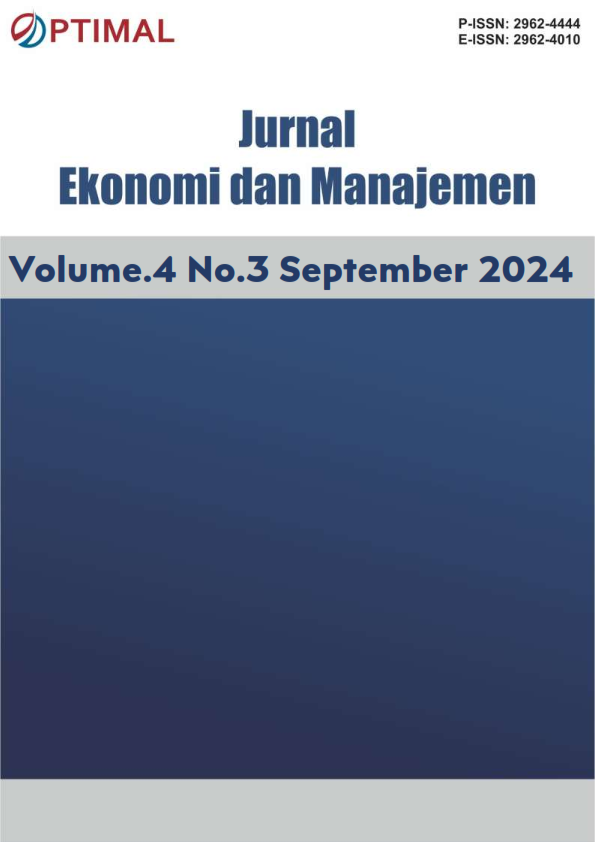Analisis Faktor-Faktor yang Mempengaruhi Ketimpangan Pembangunan pada 34 Provinsi di Indonesia Ditinjau dari Perspektif Ekonomi Islam
(Studi pada Tahun Periode 2019-2023)
DOI:
https://doi.org/10.55606/optimal.v4i3.4118Keywords:
Inequality, economic growth, investment, populationAbstract
Often, backward territories exploit the inequalities of economic and social development to enhance their own economic potential. It can boost economic growth by encouraging innovation and efforts to harness existing local resources. It is important to remember that no development model is suitable for all because each region has different potential and difficulties. The research consists of a free variable, namely economic growth (GDP), investment, and population, and a bound variable that is the inequality of economic development. The aim of this study is to identify the factors that influence the inequality of economic development in Indonesia both simultaneously and partially. The hypothesis is tested using the panel data regression method. Data analyzed with the Eviews10 program. The results of the research showed that in the F (simultaneous) test, economic growth, investment, and population numbers had a positive and significant influence on the inequality of economic development with a sig value of F 0.03<0,05. The results of the t (partial) test showed that economic growth did not have a significant impact on economic development inequality, with a sigt value of 0,054>0.05, investment had no significant impact, with sigt values of 0,93>0.05 and the population variable had a significant effect on the inequity of economic development, with the sigt worth of 0,02<05. So it can be concluded that only the population variable has a significant influence on the economic development inequality of the 34 provinces in Indonesia.
References
Hill, H., Khan, M. E., & Zhuang, J. (2013). Membangun perekonomian Indonesia yang inklusif dan berkelanjutan. Masyarakat Indonesia, 39(1).
Kurniawan, D., Hermawan, W., Sunandi, I., & Fadhila, S. Z. (2021). Pendekatan hukum terhadap isu-isu lingkungan dalam pembangunan berkelanjutan: Tantangan dan prospek. Journal on Education, 3(4), 643–658.
Latuheru, A. (2020). Pengaruh sektor tersier terhadap produk domestik regional bruto (PDRB) di Kabupaten Tolikara. Jurnal Ekonomi dan Bisnis, 11(1), 16–24.
Maltus, D. T. R. (n.d.). Asuransi syari’ah dan asuransi konvensional.
Nasution, M. (2022). Potensi dan tantangan blue economy dalam mendukung pertumbuhan ekonomi di Indonesia: Kajian literatur. Jurnal Budget: Isu dan Masalah Keuangan Negara, 7(2).
Panjaitan, H. A. M., Mulatsih, S., & Rindayati, W. (2019). Analisis dampak pembangunan infrastruktur terhadap pertumbuhan ekonomi inklusif Provinsi Sumatera Utara. Jurnal Ekonomi dan Kebijakan Pembangunan, 8(1), 43–61.
Restiatun, R. (2009). Identifikasi sektor unggulan dan ketimpangan antarkabupaten/kota di Provinsi Daerah Istimewa Yogyakarta. Jurnal Ekonomi & Studi Pembangunan, 10(1), 30666.
Rinardi, H., Indrahti, S., & Masruroh, N. N. (2023). Ketimpangan ekonomi Jawa dan luar Jawa dan perkembangan perdagangan antarpulau di Indonesia. Jurnal Sejarah Citra Lekha, 8(1), 29–43.
Tandelilin, E. (2001). Analisis investasi dan manajemen portofolio. BPFE.
Zafar, I., & Areef, S. (2010). Indonesia: Kendala kritis bagi pembangunan infrastruktur. Islamic Development Bank.
Downloads
Published
How to Cite
Issue
Section
License
Copyright (c) 2024 Riski Doni Damara, Madnasir Madnasir, Nurhayati Nurhayati

This work is licensed under a Creative Commons Attribution-ShareAlike 4.0 International License.








